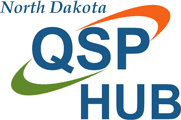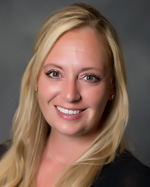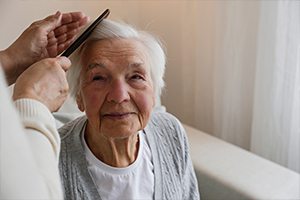Helping the Helpers
By Jena Pierce on
For many elderly individuals, one of their main goals is to live in their home, in their community, for as long as possible. As bodies and minds age, however, remaining in the home can be a challenge for individuals and their spouses. This is where Qualified Service Providers (QSPs) come into play.
A North Dakota Model
QSPs are unique to North Dakota. They provide the care that allows someone to remain in their home rather than move to a care facility. They can operate as an individual QSP or work for an agency QSP. QSPs must meet all state standards and requirements and be enrolled with the North Dakota Health and Human Services (HHS) as a provider.
 QSPs can choose to be
self-employed or work for an agency. They can also choose
to start their own agency where they then employ people
to work as QSPs. Since individual QSPs are self-employed,
they need to know how to run a small business. They need
the knowledge of electronic visit verification,
documentation, billing, and other business operations.
Agencies have similar needs. And now they can turn to the
North Dakota
Qualified Service Provider Hub (QSP Hub) for
education, support, and resources.
QSPs can choose to be
self-employed or work for an agency. They can also choose
to start their own agency where they then employ people
to work as QSPs. Since individual QSPs are self-employed,
they need to know how to run a small business. They need
the knowledge of electronic visit verification,
documentation, billing, and other business operations.
Agencies have similar needs. And now they can turn to the
North Dakota
Qualified Service Provider Hub (QSP Hub) for
education, support, and resources.

Daniall Deis, senior project coordinator, started with the QSP Hub in 2022, when the program was created at the Center for Rural Health, housed within the University of North Dakota School of Medicine & Health Sciences. Having worked as a teacher, she began as an education coordinator at the QSP Hub and created how-to videos explaining the different processes QSPs need to work through, along with answering the Hub's call and email lines.
"We weren't entirely sure what QSPs were going to need help with," Deis explained, "but we had an idea it would be business processes so that is where we started. I was the sole person on the team originally, getting about 12-25 calls a week. Three years later, we have myself, and three resource facilitators, averaging more than 185 calls every week. The workload has increased immensely in a short period of time."
The workload has increased immensely in a short period of time.
In addition to supporting the many needs of providers, the QSP Hub has focused its efforts on the recruitment and retention of providers. Providing education, training, and outreach efforts will help sustain quality providers in the long term.
The QSP Hub works hand-in-hand with North Dakota HHS, often referring clients to each other, depending on what help is needed.
Deis shared the close working relationship between the two programs. "The QSP Hub has also been a critical support with the transition from paper application to the new web portal system and the many other updates and changes that come from North Dakota HHS. We are often the program sharing updates directly to many of the individual and agency QSPs."
Survey of Needs
Annually the QSP Hub conducts a survey to find out if they are meeting the needs of QSPs or if there are areas that could be improved. Key findings from the 2024 survey include:
- Over half of individual QSPs reported serving clients under 65 years of age.
- The service most commonly provided by individual and agency QSPs was homemaker service.
- When asked how influential various factors were in becoming a QSP, the desire to help others/make a difference in people's lives was the most frequently rated as extremely influential.
- Paperwork was the most commonly noted challenge of working as an individual QSP.
- On average, QSPs employed by an agency make $18.00 – 19.00 per hour.
- When asked how long, on average, a QSP position is open before it is able to be filled, the most common response was 1-3 months.
Questions and Answers
Deis shared that the QSP Hub receives a variety of questions across all topic areas. Common technical assistance areas include enrollment, revalidation, and billing and claims.
My team works to create a positive experience with each person they support.
"My team works to create a positive experience with each person they support," explained Deis. "Often, when people call us, they are very frustrated and helping to reassure them we will help is key. We always provide a call/email back within 2 business days. Often, it will be the same day depending on the time that the call comes in. We also operate from the stance that if we cannot directly help solve the problem, we provide a contact or resource as a next step that can."
Global Care is Filling a Need
 Bishal Khadka is the owner of the
QSP agency Global Care, based out of Fargo, North Dakota.
Originally from Nepal, he worked as a caregiver in early
2024 and recognized a growing need for this type of care
within the Bhutanese-Nepali community. He opened his
agency in mid-2024, and within six months had 12 QSPs
working with him, primarily serving elderly individuals
in the community.
Bishal Khadka is the owner of the
QSP agency Global Care, based out of Fargo, North Dakota.
Originally from Nepal, he worked as a caregiver in early
2024 and recognized a growing need for this type of care
within the Bhutanese-Nepali community. He opened his
agency in mid-2024, and within six months had 12 QSPs
working with him, primarily serving elderly individuals
in the community.
"When I first started, there was a lot to figure out. Everything from completing applications to understanding compliance requirements," Khadka shared. "I just took it step by step, and now I feel confident handling billing, onboarding, training, and keeping things running smoothly."
He began working with the QSP Hub when he was starting his agency.
No matter how many questions I've had, they've been quick, helpful, and kind. I truly rely on them as a trusted resource.
"I've reached out to them more times than I can count," Khadka said. "What I appreciate most is how thorough their responses are. No matter how many questions I've had, they've been quick, helpful, and kind. I truly rely on them as a trusted resource."
The biggest need Khadka has seen is requests for personal care services. That includes help with hygiene, medication reminders, maintaining a clean environment, meaningful interaction to prevent loneliness, and more.
"When clients are happy with the care they receive, you can see the difference," Khadka said. "They're truly grateful, and it means a lot to know we're making a positive impact."
Rural Needs for QSPs
Lynelle Osvold is a home and community-based services (HCBS) social worker, working in the northeast corner of the state, largely covering the counties of Pembina and Cavalier and parts of Grand Forks. She has been doing this job for 20 years and is employed by North Dakota HHS.
"My primary role is working with the individuals who need services in their home," Osvold said. "I conduct an assessment to see if the individual qualifies for the different funding sources to receive help for care at home. From there, they have their choice of a provider. However, to be able to receive state and federal dollars, they need to work with a state approved QSP."
 Osvold and Deis believe
the need for home and community-based care options will
continue to increase. With the baby boomers that are now
aging into services and the vast population of elderly in
North Dakota, there will be an ongoing need for providers
in our state. It is important to note that anyone over
the age of 18 can apply to be a QSP, and may be family
members.
Osvold and Deis believe
the need for home and community-based care options will
continue to increase. With the baby boomers that are now
aging into services and the vast population of elderly in
North Dakota, there will be an ongoing need for providers
in our state. It is important to note that anyone over
the age of 18 can apply to be a QSP, and may be family
members.
"The goal of HCBS is that a person has the ability to receive services where they want to, in their own home or community. It's the power of choice and we want to make sure people know you can receive care at home if you want to or if you feel more comfortable you can go to nursing home care, basic care, or assisted living. We support the full continuum of care, where people want to receive that care."
Recently, North Dakota HHS has moved from a paper application process to a fully online application process, which has shown a need for technical assistance, especially for individual QSPs.
I have told new providers there is a ton of training on the QSP Hub website.
Osvold shared, "If a provider has questions, the QSP Hub can explain the process. I have told new providers there is a ton of training on the QSP Hub website. The providers that have taken the training found it to be very helpful. It is a great resource, and they provide needed support."


 is the communications manager at the Center for Rural
Health at the University of North Dakota School of
Medicine & Health Sciences in Grand Forks.
is the communications manager at the Center for Rural
Health at the University of North Dakota School of
Medicine & Health Sciences in Grand Forks.



